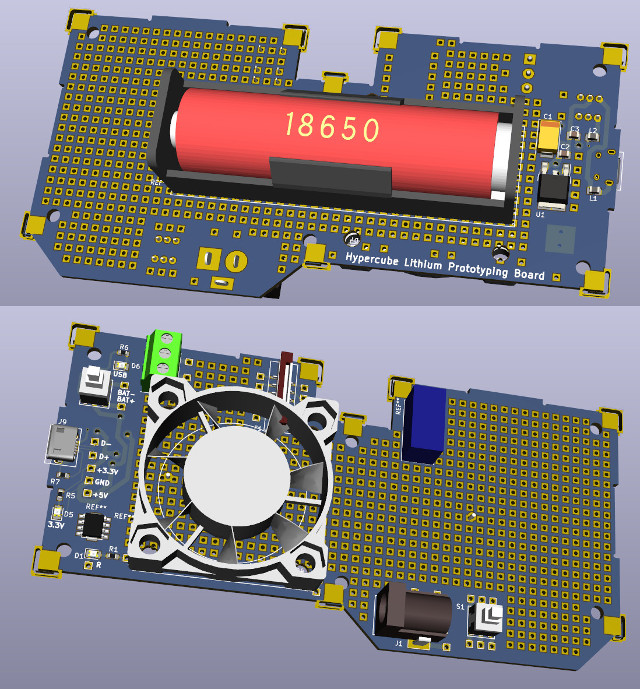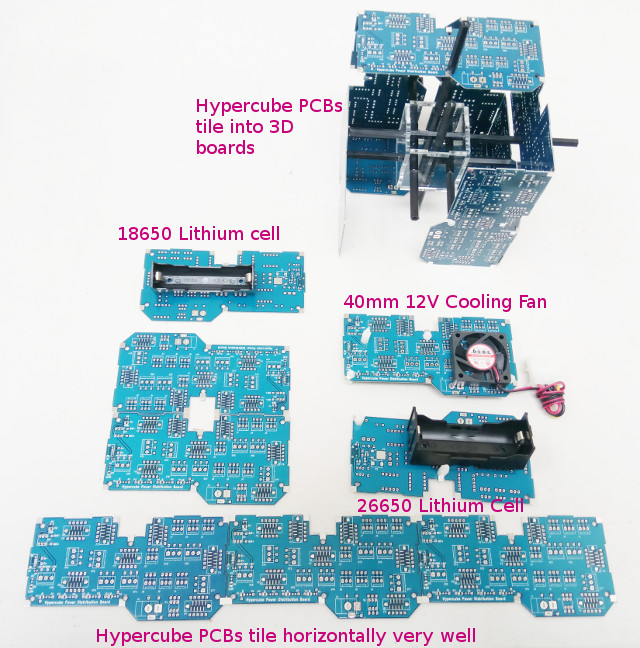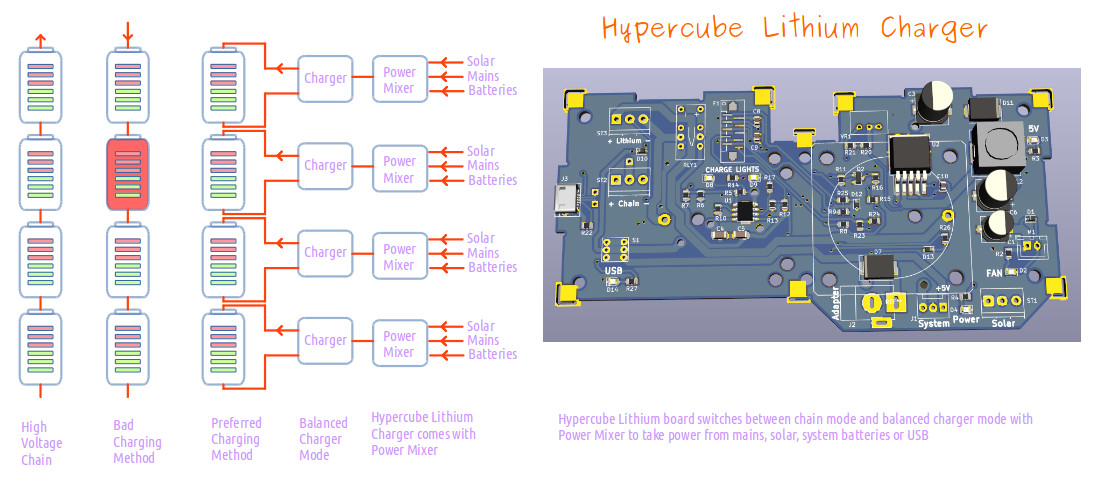Hypercube Developer Website
Hypercube Lithium Prototyping Board
 The rational behind a Synthetic AI Hand Project is straight forward. The entire human race civilization is built by a pair of hands duplicated over and over again doing the little things that collectively becomes civilization. So if we could make a pair of really good AI infused synthetic hands, only one pair of hands would ever get built, and the rest are all just duplicates. Project details: Synthetic AI Hand Project |
KiCAD based Linux ARM SoC boards are now under development. These boards are open sourced with more to come in the future. The boards here are support boards for Hypercube projects. This is a Lithium charger board with option to fit cooling fan, and remote control relay to switch between normal operation connected into serial battery packs and then into 'balanced' charge mode operation where each battery is charged individually according to its current state of charge. Hypercube can house 12 18650 Lithium battery boards.   Design checks show there is space for six 26650 Lithium cells inside a Hypercube. The footprints for the 18650 and 26650 could be merged to allow either battery to be fitted. How to make Intelligent Lithium battery packs for autonomous systems  We don't normally put too much effort into making intelligent battery but this oversight can weaken a whole project that needs to autonomously manage battery power. Particularly for autonomous devices that need to work out how long it can run for. The Hypercube boards are being developed with a view to open sourcing the KiCAD circuits together with ST versions of Arduino software to intelligently control the charger boards. The problem that needs solution is that batteries need to operate connected in series to generate higher voltages, but each battery would like to be charged individually at low voltage. If we try to charge a long string of batteries at high voltage, one of the cells could be weak or damaged in the string, and this would put the whole battery pack at risk of fire if we try to charge that pack. So each battery in each string of batteries need to be managed separately. For longevity, Lithium batteries would like to be charged hot and fast to destroy microscopic needles that might otherwise form when charged slowly and puncture the battery electrolyte chemical separation layers causing a short circuit. The needle formation processes are easy to see if the battery is built from transparent materials in laboratory conditions. The chemical mixtures can be varied to see what changes to materials can be made to mitigate needle formation, but this kind of research and development is a long process. At the same time batteries cannot be charged too hot and too fast because the battery chemistry does not support it. Battery packs need individual thermal sensors to distinguish a damaged battery that is overheating from a battery that is being charged hot and fast. A good battery will remain cool despite drinking lots of charging current. An efficient battery is one that remains cold until it is fully charged because if it wastes energy then it will get hot. The charge/discharge cycle with 100% efficiency means the battery never gets warm! Supercapacitors on the other hand cannot do this. Supercapacitors convert a third of the charging energy into heat due to physics. A supercapacitor is never as efficient as a battery. But on the other hand, a supercapacitor can instantly switch between discharge mode to charge mode. So they are very good for absorbing energy from regenerative braking. Batteries cannot compete with supercapacitors here because to go from discharge mode to efficient charging mode takes several minutes to get the battery chemistry to reverse. To mitigate against this problem, the battery strings need to be partitioned into two sets. One set that is discharging, and another set that is charging. Only those that have been charging for a few minutes can efficiently absorb surge power such as those coming from regenerative braking, or solar panels on a cloudy day as the sun gets blocked by chunks of cloud passing overhead. The Hypercube Lithium charger prototyping board is designed to take all these scenarios into account with a power mixer. The power mixer accepts mains power, solar power, and battery power. If the system is starting up, it takes all its power from mains. If renewable solar and/or wind generator is connected then providing it is generating more power than minimum mains power, then the power mixer will use solar energy. If there is already a set of charged batteries available, and software has worked out that the battery is not immediately needed, then the charger can use the battery reserves to optimally charge the discharge battery. If solar or wind come on stream as surge power, then the battery drain is automatically cut back to allow the solar power to be maximally absorbed. For longevity, batteries should not be left to idle in the fully charged state because that also allows needle formation and quicker deterioration of battery. About 60% is a good starting point. So Intelligent software needs to balance which strings of batteries need a full charge, and which can be left at 60%. These numbers are slightly different for different types of Lithium batteries, so the software needs to be customized for different types of Lithium cells according to manufacturer datasheets. The way to string batteries into a long chain is to use a DPDT relay to generate high voltage, and when its time for them to be charged, switch the relay on to rewire the each cell to individual chargers. These individual chargers can personalize the delivery of charge to each cell and with it bring risk reduction by indicating which cell is not following expected norms. The Intelligent battery pack should also be able to decide which strings are to be charged, and which strings are left supplying power to the autonomous device or vehicle it is providing power for. Adding separate DPDT relays to each string of battery can put them into service if they are safe to use, take them out of service, or take them offline for charging. The autonomous device can then decide where and when to get its batteries recharged with the least amount of down time as well as report on any string of batteries with failed cells. |
 Hypercube PCBs come with their own interchangeable software to mix and match functions as needed. Designed around IoT needs, we make prototyping work fast and effortless. |
| I Home | More | | ||
 Electronics Store Opening Soon |
||
Copyright (C) Hypercube Semicondutors 2018 |